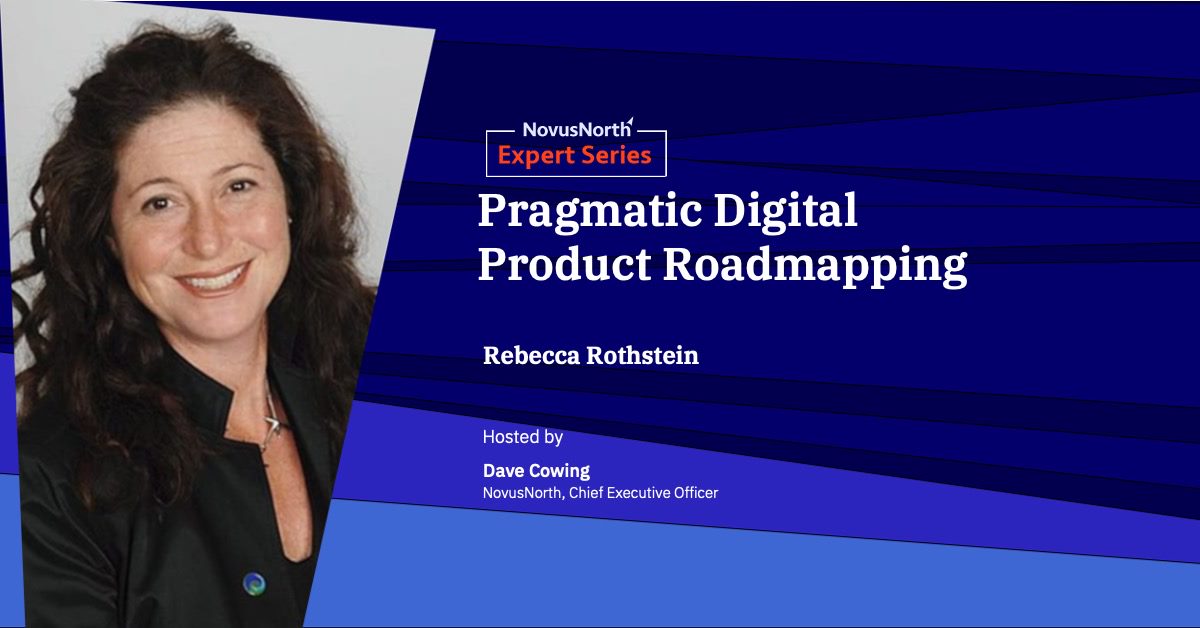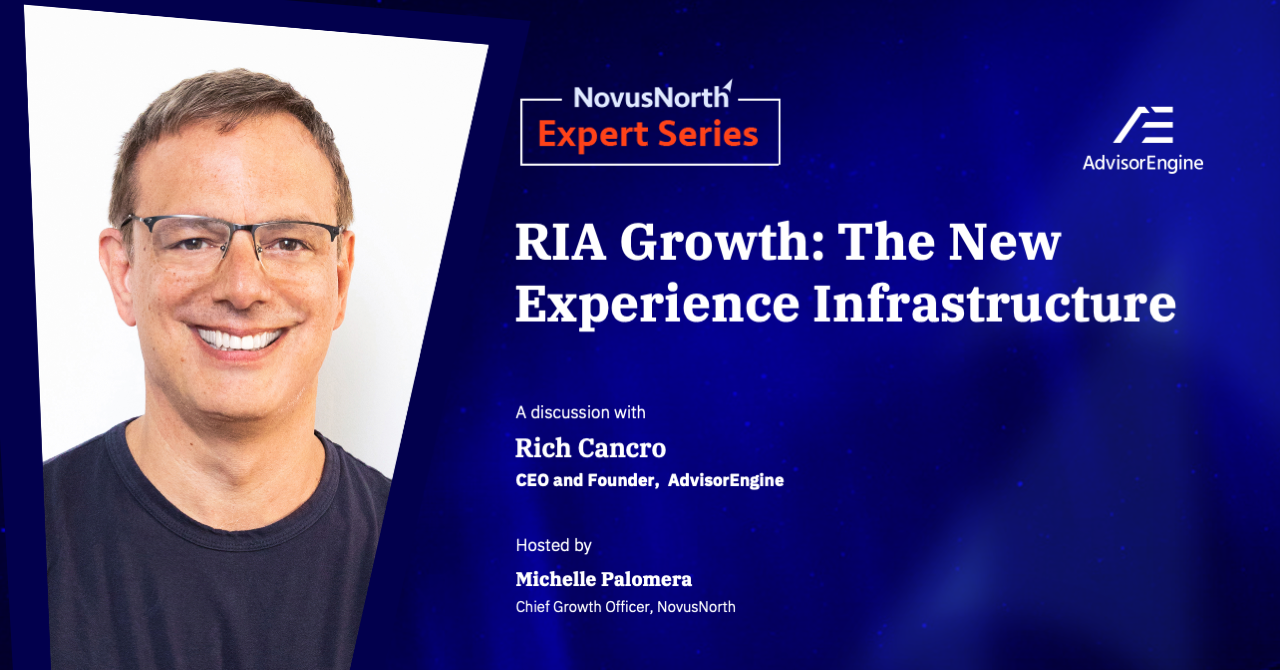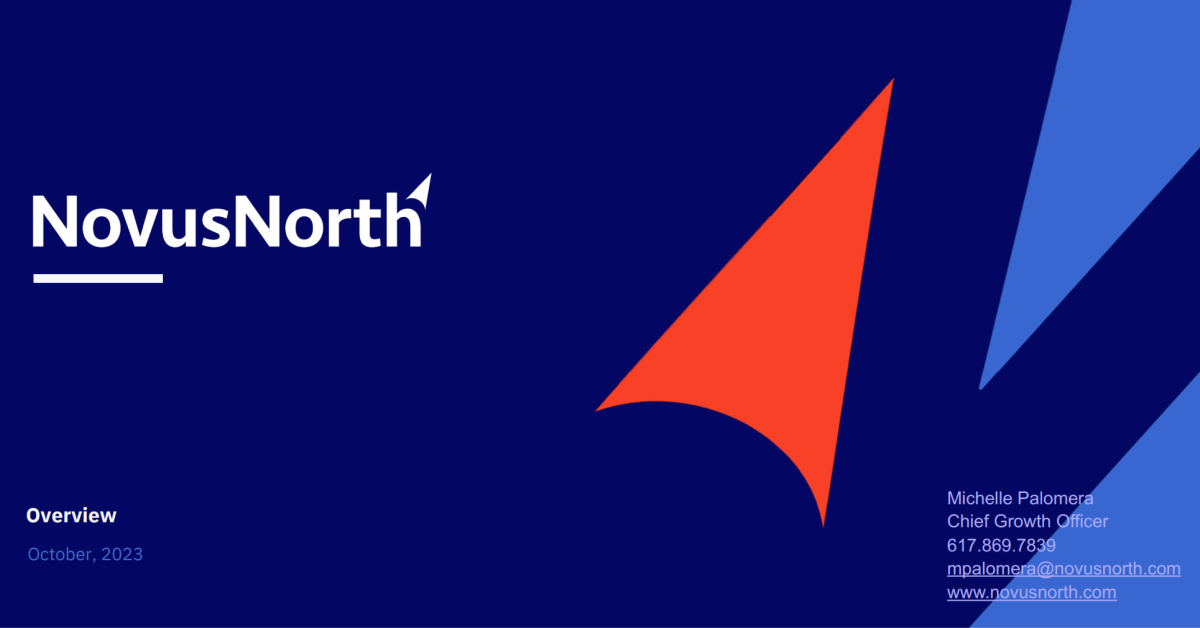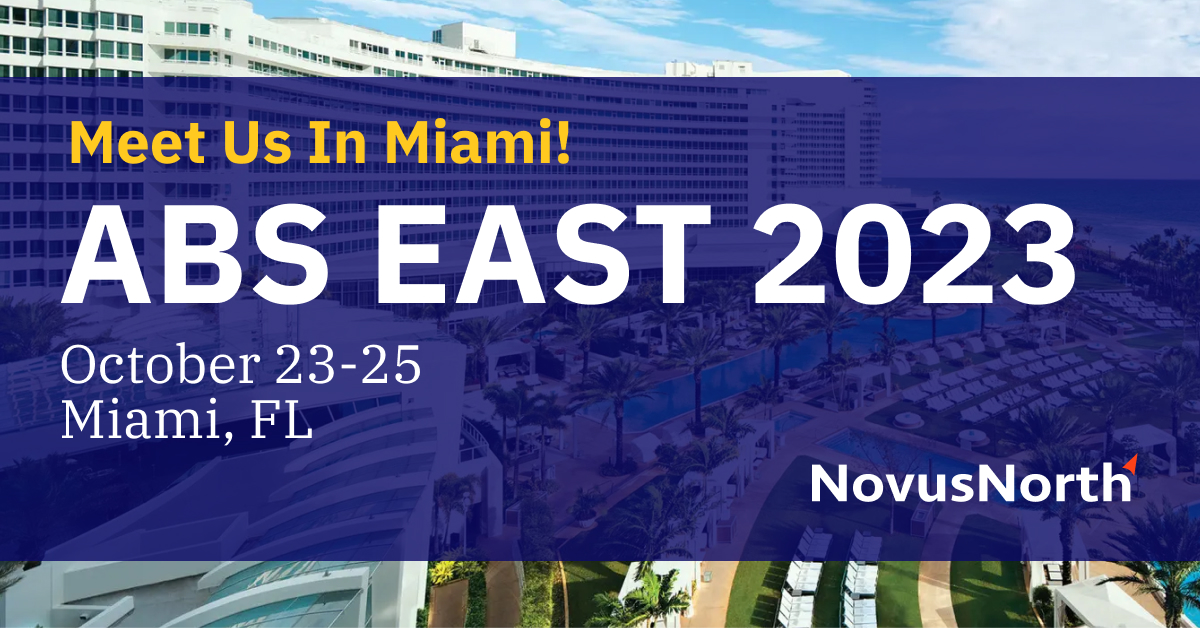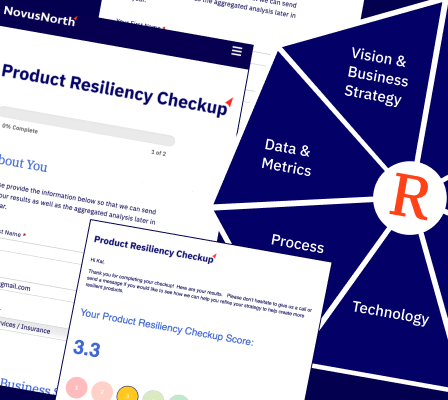In this edition of NovusNorth’s thought leadership conversation, Dave Cowing had an opportunity to speak with Rebecca Rothstein, Director of Digital Banking and acting Marketing Director at OceanFirst Community Bank.
Rebecca has held leadership roles at various companies, including, Managing Consultant at Capgemini; Director of User Experience at TandemSeven (currently Genpact); founder of Bullseye Research & Design; and Vice President and Customer Experience Program Manager at JP Morgan Chase. Rebecca is committed to helping others and donated her time to her community, currently serving as a Board member of Swimming to Help in NJ.
Rebecca is an advocate for digital innovation and delivering exceptional customer experiences with a history of repositioning business challenges as opportunities, identifying unmet needs through user research, and developing achievable strategic roadmaps with measurable results.
NovusNorth is an expert-lead provider of product design, development, and delivery services for the FinTech and financial services industry. At NovusNorth, we believe that great digital experiences drive great business outcomes.
In this article, we summarize the conversation between Dave and Rebecca.
Read the Transcript
Q: You’ve been leading customer experience and digital teams in multiple industries. How do you go about deciding what the customer really needs?
Rebecca Rothstein
For me it’s always about listening; listening to your customers, listening to your team, listening to your technology partners. Because, particularly as a community bank, you need to convince them that they need to listen to you as an advocate for your customer, even though it might be a one size fits all solution that they don’t really want to make changes on.
“..it’s always about listening; listening to your customers, listening to your team, listening to your technology partners”
– Rebecca Rothstein
“..it’s always about listening; listening to your customers, listening to your team, listening to your technology partners”
– Rebecca Rothstein
Q: How has this changed over time?
Rebecca Rothstein
Well, until about 10 years ago, I’d say you had to actively go out and seek your customer’s feedback. And those were always my favorite projects. Think you once sent me on a six-week project to Georgia, to work on a research project for an insurance company. And it was so much fun, because all you do is think about what you want to do and what could make something better, you don’t actually have to build it, fix it.
“You have feedback flooding in from a gazillion different channels”
– Rebecca Rothstein
“You have feedback flooding in from a gazillion different channels”
– Rebecca Rothstein
Today, it’s a lot different. You have feedback flooding in from a gazillion different channels. And there’s always a new one that you’ve got to figure out how to collect the feedback and how to respond to it. I try to dedicate an hour or two every week just to read the Google reviews and the NPS surveys, the customer care data, even the branch feedback. Spending time in our branch network, you always learn because they’re on the frontline and they have the responsibility of being like a genius bar, where someone comes in and says my mobile app doesn’t work, fix it, and this is someone who is an entry level teller, they need to have the skills and the confidence to be able to say, I can help you with that. So there are a lot of different ways that feedback comes in.
The challenge for me is always not falling immediately down the rabbit hole of saying wow, that customer is really angry I need to fix their problem. But instead spending the time just gathering all of the ideas. Putting them together.
What hasn’t changed is selecting the right ideas and really understanding the time, money and team bandwidth you have available to determine what can you feasibly build. Another thing that hasn’t changed that I remember at my time at Chase, is that you have many projects going on at a time and some are dependent on others. Some of them start, some of them stop, some of them suddenly are ready and you have to keep juggling how the projects are working together and the team’s time to be able to deliver on all of these successfully. What has changed incredibly, dramatically is the amount of time you have to do these things. Customers expect you to fix their problem, immediately. They expect you to come out with new releases immediately. And it’s challenging. You really need to prioritize it and, I’m probably stating the obvious, you need to be able to course correct frequently. Particularly if you move really slow. I mean, there are disruptors that come out with a completely new feature or functionality before you’ve even released that thing that you’ve been working so hard on, and maybe it’s not so impressive to customers anymore. So it’s a constant challenge.
“Customers expect you to fix their problem, immediately”
– Rebecca Rothstein
“Customers expect you to fix their problem, immediately”
– Rebecca Rothstein
Q: So how do you decide what ideas to move forward?
Rebecca Rothstein
It’s a constant discipline, that I that I try very hard to keep a roadmap. And a roadmap means many different things to many different people. But to me, it’s this visual depiction of all the ideas you’ve generated, but you’ve broken it down into what we’re going to do now, what’s later, and what’s wish list that we have no idea how we’re going to do, but it was a great idea.
My first experience with the roadmap was at an E-business innovator, which is long gone, called Scient. I was instantly smitten with it, because it was this one place, it was this idea catcher they called a scope map. I just I love the idea, and I still do, that you have everything captured in one place. Then the hard part is where you have to sit all your clients down in a room, because that’s what we did back in the day, you’d all get together in a room and for three days, you just go item by item, prioritizing it. And everyone wanted to kill you or kill each other, you know, there’s got to be some lively discussion. But where I would find something at high priority and the business owner, the technology architect on the team, where we all thought something was a winner, it was truly a winner. Those were the best ideas when we all came together. It’s a difficult process. But just when you know you finally get through it, you hit that magic macro button it was magical. And it gave you this visual of here’s what you’re going to do for your first release. Here’s what’s going to be future. You knew what was coming. And you had a clearly defined, with some last-minute haggling, MVP. And I mean, minimum viable product, not an athlete. But it is that agreement where the team says this is that winning first release, this is what we’re going out with, this is what we’re going to put our heart into initially. What I appreciated about that tool is not only did it give you that clearly defined roadmap, but it also it also helped you to adjust and shift. So over time, you knew, we went down this path and we couldn’t do this feature, but hey, this one’s next up, move it on there. You didn’t have to go back to the drawing board. You already had this backlog of things that you could move forward with.
“I had 3 days to come up with a budget”
– Rebecca Rothstein
“I had 3 days to come up with a budget”
– Rebecca Rothstein
Q: Do you have any advice on prioritization?
Rebecca Rothstein
I’m always learning, there’s always lessons learned constantly. But I’d say the number one for me always comes back to make yourself truly prioritize, you can’t do everything and be successful. And remember, so many times clients would say, if I don’t get it in this one, then it’ll never happen. Well, then it’ll never happen, you know, just let it go. Focus on what you believe you can achieve, so that you can truly deliver on it. And maybe exceed expectations. That’s never a bad thing.
“pick a few easy ones…you have to have short wins along the way”
– Rebecca Rothstein
“pick a few easy ones…you have to have short wins along the way”
– Rebecca Rothstein
Try not to think of only the big, massive, critical projects, pick a few easy ones. I worked on a game a long, long time ago. And it was an awesome game, I loved it, it was so visually beautiful. When we got to gold master Time Warner decided they didn’t really want to do cd rom games anymore. So it was like almost a year and a half of my life, a long time to not have anything to show for it. And it taught me a valuable lesson, you have to have short wins along the way. Because people need to feel they’ve accomplished something, I need to feel I have accomplished something and you need to be able to celebrate a win.
You also need to leave a little bit of bandwidth because that stuff happens, customers point out things that are broken, you need to leave time for fixes. Those projects come up and they have to be a priority. So you don’t want to make it so that you can’t get everything done. You want to set the team up to be successful and to win.
For each idea, I also like to think about how much of a positive impact that project will have on your customers and on your ability to serve them. Or will it automate some process that’s really manual. There are so many different ways that you can think about your priority, it’s up to you to decide what is the most important.
Another thing is if it’s really expensive and it’s going to eat up 80% of your budget for the year. Are you sure it’s really worth it? Because if you’re even questioning it, you probably should look away, because there may be so much more we could do to have a more meaningful impact, do 10 projects instead of that one. That way, every month or so you’re delivering something you’re showing improvement. Because you can always revisit in six months. It’s an idea. It’s on the roadmap. It may be in the future wish lists section, but it’s there. And technology changes, it might be something that you can do six months from now.
Q: How do you maintain your team and stakeholder’s excitement when some elements of the roadmap are so far out?
Rebecca Rothstein
It’s another activity that that I probably grumble about the most because I spent four or five hours, with three members of my team, each month putting together a KPI dashboard, if you will. But I think it’s really important we spend an hour as a team actually with my boss, just going through it every month. It forces you to think about how are we progressing on our roadmap? What have we completed, so we get to celebrate, right? As well as how are the things that you did performing. And you notice things, you know, when you’re looking at that data, if you force yourself to take the time that there’s issues that you need to address, or hey, we’re doing really, we’re doing better than we thought we would do. We take that time, every month. Also every other month, I do a digital update for the CEO and CEO, and share with them what we’re working on. Give them a snapshot of the roadmap. So they know we have a plan, we have a strategy, and we’re delivering on it. I think that’s important that they hear because then when they go out, and they talk to investors, and they love to talk about digital and our investment in digital, which is perhaps unusual for most community banks. It’s a great talking point for them. So I like to give them a little nuggets and information that they can share along the way.
Q: What are the top 3 lessons/tips you’d share in managing a product in an emerging tech space?
Rebecca Rothstein
Maybe it’s my personal style, but for me, the number one thing is always collaboration. And I think collaboration wins, mostly in that when we would do client engagements where if you went in and told them, here’s your roadmap, they didn’t own it, so they didn’t take it forward. So I feel it’s really important that you ensure that your team has ownership. They’re part of the process throughout the prioritization, the generating of the ideas, the managing of the roadmap and keeping it up to date. And the only way to do that is to ensure that they’re part of the process from the beginning.
“it’s really important that you ensure that your team has ownership”
– Rebecca Rothstein
“it’s really important that you ensure that your team has ownership”
– Rebecca Rothstein
Number two, don’t wait until you need pricing, or even just to do a somewhat investigative look at the technology involved. I’ve gotten caught a few times, where I thought I’d picked this wonderful feature or function that was going to be very easy to implement, but it required some very expensive interface or data feed. Like you’ll notice all the banks are doing, “check out your FICO score”, right? They all offer it. Well, for me to turn that on, I needed also to have a relationship with the company that was providing the scores, not just the company that displays them. And so there were a lot of other factors to it, that made it something that wasn’t going to happen on our roadmap. So it’s good to at least understand the basics of your idea, especially if it’s something that you think is in the near term, that you might want to be able to pull it up, especially if another project stops and you need to put something in its place. You don’t want to be starting at zero. I think that’s an important number two.
The last one is just be willing to adapt because as I said, things start and stop. Change happens, especially when a new disrupter comes in or a new technology becomes available. It seems like real time payments have been around forever, but they keep changing. And the players keep changing and things like that. I mean, you need to adapt, roadblocks happen. Keep moving. You have an endless backlog on your roadmap. It’s not a problem. You just move forward and celebrate the wins.
About The Experts
Rebecca Rothstein
Marketing Director at OceanFirst Community Bank
Rebecca has held leadership roles at various companies, including, Managing Consultant at Capgemini; Director of User Experience at TandemSeven (currently Genpact); founder of Bullseye Research & Design; and Vice President and Customer Experience Program Manager at JP Morgan Chase. Rebecca is committed to helping others and donated her time to her community, currently serving as a Board member of Swimming to Help in NJ. Rebecca is an advocate for digital innovation and delivering exceptional customer experiences with a history of repositioning business challenges as opportunities, identifying unmet needs through user research, and developing achievable strategic roadmaps with measurable results.

Dave Cowing
Chief Executive Officer and Co-Founder of NovusNorth
NovusNorth is an outcome-oriented experience consultancy that drives business results by creating compelling experiences for customers and employees in the fintech and financial services industry. Dave has 30 years of experience helping companies ranging from Fortune 500 market leaders to disruptive startups with new ideas.
In this edition of NovusNorth’s thought leadership conversation, Dave Cowing had an opportunity to speak with Rebecca Rothstein, Director of Digital Banking and acting Marketing Director at OceanFirst Community Bank.
Rebecca has held leadership roles at various companies, including, Managing Consultant at Capgemini; Director of User Experience at TandemSeven (currently Genpact); founder of Bullseye Research & Design; and Vice President and Customer Experience Program Manager at JP Morgan Chase. Rebecca is committed to helping others and donated her time to her community, currently serving as a Board member of Swimming to Help in NJ.
Rebecca is an advocate for digital innovation and delivering exceptional customer experiences with a history of repositioning business challenges as opportunities, identifying unmet needs through user research, and developing achievable strategic roadmaps with measurable results.
NovusNorth is an expert-lead provider of product design, development, and delivery services for the FinTech and financial services industry. At NovusNorth, we believe that great digital experiences drive great business outcomes.
In this article, we summarize the conversation between Dave and Rebecca.
Read the Transcript
Q: You’ve been leading customer experience and digital teams in multiple industries. How do you go about deciding what the customer really needs?
Rebecca Rothstein
For me it’s always about listening; listening to your customers, listening to your team, listening to your technology partners. Because, particularly as a community bank, you need to convince them that they need to listen to you as an advocate for your customer, even though it might be a one size fits all solution that they don’t really want to make changes on.
“..it’s always about listening; listening to your customers, listening to your team, listening to your technology partners”
– Rebecca Rothstein
“..it’s always about listening; listening to your customers, listening to your team, listening to your technology partners”
– Rebecca Rothstein
Q: How has this changed over time?
Rebecca Rothstein
Well, until about 10 years ago, I’d say you had to actively go out and seek your customer’s feedback. And those were always my favorite projects. Think you once sent me on a six-week project to Georgia, to work on a research project for an insurance company. And it was so much fun, because all you do is think about what you want to do and what could make something better, you don’t actually have to build it, fix it.
“You have feedback flooding in from a gazillion different channels”
– Rebecca Rothstein
“You have feedback flooding in from a gazillion different channels”
– Rebecca Rothstein
Today, it’s a lot different. You have feedback flooding in from a gazillion different channels. And there’s always a new one that you’ve got to figure out how to collect the feedback and how to respond to it. I try to dedicate an hour or two every week just to read the Google reviews and the NPS surveys, the customer care data, even the branch feedback. Spending time in our branch network, you always learn because they’re on the frontline and they have the responsibility of being like a genius bar, where someone comes in and says my mobile app doesn’t work, fix it, and this is someone who is an entry level teller, they need to have the skills and the confidence to be able to say, I can help you with that. So there are a lot of different ways that feedback comes in.
The challenge for me is always not falling immediately down the rabbit hole of saying wow, that customer is really angry I need to fix their problem. But instead spending the time just gathering all of the ideas. Putting them together.
What hasn’t changed is selecting the right ideas and really understanding the time, money and team bandwidth you have available to determine what can you feasibly build. Another thing that hasn’t changed that I remember at my time at Chase, is that you have many projects going on at a time and some are dependent on others. Some of them start, some of them stop, some of them suddenly are ready and you have to keep juggling how the projects are working together and the team’s time to be able to deliver on all of these successfully. What has changed incredibly, dramatically is the amount of time you have to do these things. Customers expect you to fix their problem, immediately. They expect you to come out with new releases immediately. And it’s challenging. You really need to prioritize it and, I’m probably stating the obvious, you need to be able to course correct frequently. Particularly if you move really slow. I mean, there are disruptors that come out with a completely new feature or functionality before you’ve even released that thing that you’ve been working so hard on, and maybe it’s not so impressive to customers anymore. So it’s a constant challenge.
“Customers expect you to fix their problem, immediately”
– Rebecca Rothstein
“Customers expect you to fix their problem, immediately”
– Rebecca Rothstein
Q: So how do you decide what ideas to move forward?
Rebecca Rothstein
It’s a constant discipline, that I that I try very hard to keep a roadmap. And a roadmap means many different things to many different people. But to me, it’s this visual depiction of all the ideas you’ve generated, but you’ve broken it down into what we’re going to do now, what’s later, and what’s wish list that we have no idea how we’re going to do, but it was a great idea.
My first experience with the roadmap was at an E-business innovator, which is long gone, called Scient. I was instantly smitten with it, because it was this one place, it was this idea catcher they called a scope map. I just I love the idea, and I still do, that you have everything captured in one place. Then the hard part is where you have to sit all your clients down in a room, because that’s what we did back in the day, you’d all get together in a room and for three days, you just go item by item, prioritizing it. And everyone wanted to kill you or kill each other, you know, there’s got to be some lively discussion. But where I would find something at high priority and the business owner, the technology architect on the team, where we all thought something was a winner, it was truly a winner. Those were the best ideas when we all came together. It’s a difficult process. But just when you know you finally get through it, you hit that magic macro button it was magical. And it gave you this visual of here’s what you’re going to do for your first release. Here’s what’s going to be future. You knew what was coming. And you had a clearly defined, with some last-minute haggling, MVP. And I mean, minimum viable product, not an athlete. But it is that agreement where the team says this is that winning first release, this is what we’re going out with, this is what we’re going to put our heart into initially. What I appreciated about that tool is not only did it give you that clearly defined roadmap, but it also it also helped you to adjust and shift. So over time, you knew, we went down this path and we couldn’t do this feature, but hey, this one’s next up, move it on there. You didn’t have to go back to the drawing board. You already had this backlog of things that you could move forward with.
“I had 3 days to come up with a budget”
– Rebecca Rothstein
“I had 3 days to come up with a budget”
– Rebecca Rothstein
Q: Do you have any advice on prioritization?
Rebecca Rothstein
I’m always learning, there’s always lessons learned constantly. But I’d say the number one for me always comes back to make yourself truly prioritize, you can’t do everything and be successful. And remember, so many times clients would say, if I don’t get it in this one, then it’ll never happen. Well, then it’ll never happen, you know, just let it go. Focus on what you believe you can achieve, so that you can truly deliver on it. And maybe exceed expectations. That’s never a bad thing.
“pick a few easy ones…you have to have short wins along the way”
– Rebecca Rothstein
“pick a few easy ones…you have to have short wins along the way”
– Rebecca Rothstein
Try not to think of only the big, massive, critical projects, pick a few easy ones. I worked on a game a long, long time ago. And it was an awesome game, I loved it, it was so visually beautiful. When we got to gold master Time Warner decided they didn’t really want to do cd rom games anymore. So it was like almost a year and a half of my life, a long time to not have anything to show for it. And it taught me a valuable lesson, you have to have short wins along the way. Because people need to feel they’ve accomplished something, I need to feel I have accomplished something and you need to be able to celebrate a win.
You also need to leave a little bit of bandwidth because that stuff happens, customers point out things that are broken, you need to leave time for fixes. Those projects come up and they have to be a priority. So you don’t want to make it so that you can’t get everything done. You want to set the team up to be successful and to win.
For each idea, I also like to think about how much of a positive impact that project will have on your customers and on your ability to serve them. Or will it automate some process that’s really manual. There are so many different ways that you can think about your priority, it’s up to you to decide what is the most important.
Another thing is if it’s really expensive and it’s going to eat up 80% of your budget for the year. Are you sure it’s really worth it? Because if you’re even questioning it, you probably should look away, because there may be so much more we could do to have a more meaningful impact, do 10 projects instead of that one. That way, every month or so you’re delivering something you’re showing improvement. Because you can always revisit in six months. It’s an idea. It’s on the roadmap. It may be in the future wish lists section, but it’s there. And technology changes, it might be something that you can do six months from now.
Q: How do you maintain your team and stakeholder’s excitement when some elements of the roadmap are so far out?
Rebecca Rothstein
It’s another activity that that I probably grumble about the most because I spent four or five hours, with three members of my team, each month putting together a KPI dashboard, if you will. But I think it’s really important we spend an hour as a team actually with my boss, just going through it every month. It forces you to think about how are we progressing on our roadmap? What have we completed, so we get to celebrate, right? As well as how are the things that you did performing. And you notice things, you know, when you’re looking at that data, if you force yourself to take the time that there’s issues that you need to address, or hey, we’re doing really, we’re doing better than we thought we would do. We take that time, every month. Also every other month, I do a digital update for the CEO and CEO, and share with them what we’re working on. Give them a snapshot of the roadmap. So they know we have a plan, we have a strategy, and we’re delivering on it. I think that’s important that they hear because then when they go out, and they talk to investors, and they love to talk about digital and our investment in digital, which is perhaps unusual for most community banks. It’s a great talking point for them. So I like to give them a little nuggets and information that they can share along the way.
Q: What are the top 3 lessons/tips you’d share in managing a product in an emerging tech space?
Rebecca Rothstein
Maybe it’s my personal style, but for me, the number one thing is always collaboration. And I think collaboration wins, mostly in that when we would do client engagements where if you went in and told them, here’s your roadmap, they didn’t own it, so they didn’t take it forward. So I feel it’s really important that you ensure that your team has ownership. They’re part of the process throughout the prioritization, the generating of the ideas, the managing of the roadmap and keeping it up to date. And the only way to do that is to ensure that they’re part of the process from the beginning.
“it’s really important that you ensure that your team has ownership”
– Rebecca Rothstein
“it’s really important that you ensure that your team has ownership”
– Rebecca Rothstein
Number two, don’t wait until you need pricing, or even just to do a somewhat investigative look at the technology involved. I’ve gotten caught a few times, where I thought I’d picked this wonderful feature or function that was going to be very easy to implement, but it required some very expensive interface or data feed. Like you’ll notice all the banks are doing, “check out your FICO score”, right? They all offer it. Well, for me to turn that on, I needed also to have a relationship with the company that was providing the scores, not just the company that displays them. And so there were a lot of other factors to it, that made it something that wasn’t going to happen on our roadmap. So it’s good to at least understand the basics of your idea, especially if it’s something that you think is in the near term, that you might want to be able to pull it up, especially if another project stops and you need to put something in its place. You don’t want to be starting at zero. I think that’s an important number two.
The last one is just be willing to adapt because as I said, things start and stop. Change happens, especially when a new disrupter comes in or a new technology becomes available. It seems like real time payments have been around forever, but they keep changing. And the players keep changing and things like that. I mean, you need to adapt, roadblocks happen. Keep moving. You have an endless backlog on your roadmap. It’s not a problem. You just move forward and celebrate the wins.
About The Experts
Rebecca Rothstein
Marketing Director at OceanFirst Community Bank
Rebecca has held leadership roles at various companies, including, Managing Consultant at Capgemini; Director of User Experience at TandemSeven (currently Genpact); founder of Bullseye Research & Design; and Vice President and Customer Experience Program Manager at JP Morgan Chase. Rebecca is committed to helping others and donated her time to her community, currently serving as a Board member of Swimming to Help in NJ. Rebecca is an advocate for digital innovation and delivering exceptional customer experiences with a history of repositioning business challenges as opportunities, identifying unmet needs through user research, and developing achievable strategic roadmaps with measurable results.

Dave Cowing
Chief Executive Officer and Co-Founder of NovusNorth
NovusNorth is an outcome-oriented experience consultancy that drives business results by creating compelling experiences for customers and employees in the fintech and financial services industry. Dave has 30 years of experience helping companies ranging from Fortune 500 market leaders to disruptive startups with new ideas.
Let’s Talk!
Trying to find your new north? Get in touch to find out how we can work together to achieve the business outcomes you need.
Our Latest Insights
Founder and CEO, Rich Cancro, shares how AdvisorEngine applies their guiding principles of Personal, Scientific and Beautiful to create a world-class wealth management platform for Registered Independent Advisors.
By NovusNorth
A high-level over view of our financial services experience and capabilities. We deliver digital experiences. World class experiences that drive business outcomes for the financial services industry.
By NovusNorth
We will be showcasing our team’s experience in designing and building platforms spanning the value chain in structured finance and capital markets from onboarding and account opening to funding, securitization, trading, portfolio management, administration, servicing and trust/custody.
By NovusNorth
